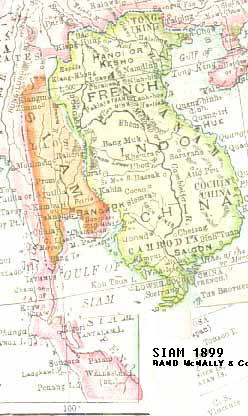 In 1893 France and Britain agreed that Siam should remain independent and not to be annexed by either of them.
In 1893 France and Britain agreed that Siam should remain independent and not to be annexed by either of them.
On January 15, 1896 :
Anglo-French Convention defined British and French spheres of influence in mainland Southeast Asia.
April 8, 1897 , Another Anglo-French convention confirmed the independence of Siam and established spheres of influence between British and French as:
Territory west of the Menam River( River of the King or Chao Phaya river ) was to be the British sphere, and that to the east was the French sphere.
Auguste Pavie, a French vice - consul at Luang Prabang in 1886, was the chief agent in furthering French interests in Laos. His intrigues, which took advantage of Siamese weakness in the region and periodic invasions by Chinese rebels from Yunnan Province, increased tensions between Bangkok and Paris. When fighting broke out between French and Siamese forces in Laos in April 1893, the French sent gunboats to blockade Bangkok. At gunpoint, the Siamese agreed to the cession of Laos. Britain's acquiescence in French expansionism was evident in a treaty signed by the two countries in 1896 recognizing a border between French territory in Laos and British territory in Upper Burma.
French pressure on Siam continued, however, and in 1907 King Chulalongkorn (Rama V) was forced to surrender Battambang and Siem Reap ( Siam Rath, -Angkor ) to French-occupied Cambodia. Two years later, Siam relinquished its claims to the northern Malay states of Kelantan, Trengganu, Kedah, and Perlis to the British in exchange for legal jurisdiction over British subjects on its soil and a large loan for railroad construction. In terms of territory under its control, Siam was now much diminished. Its independence, however, had been preserved as a useful and generally stable buffer state between French and British territories
 In 1893 France and Britain agreed that Siam should remain independent and not to be annexed by either of them.
In 1893 France and Britain agreed that Siam should remain independent and not to be annexed by either of them.